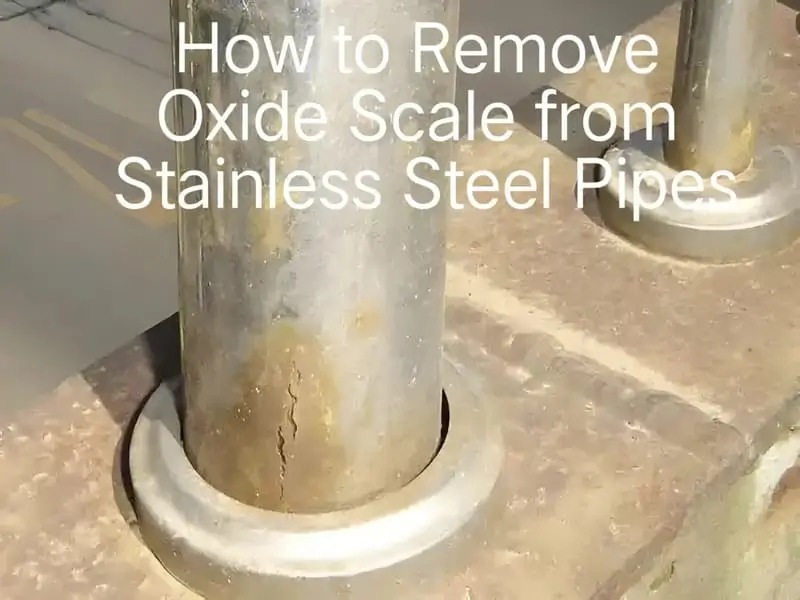How to Remove Oxide Scale from Stainless Steel Pipes/Duplex Steel Pipes
Discover How to Remove Oxide Scale from Stainless Steel Pipes/Duplex Stainless Steel Pipes/Tubes
An oxide film exists on the surface of stainless steel pipes. This film is thin and dense, exhibiting strong adhesion that resists detachment. Under standard conditions, stainless steel slabs develop 0.2–0.3mm of oxide scale when heated in a furnace. Defects within this depth range can be removed along with the oxidized iron scale. If defects lie beyond this range and surface flaws on the slab are neglected, they will inevitably be carried into the final product.
Stainless steel slabs generally cannot undergo flame descaling for surface defect removal, as flame cleaning alters the chemical composition and microstructure of the treated areas, compromising the corrosion resistance of the final stainless steel pipe product. Consequently, mechanical conditioning is a commonly used and effective method for surface treatment of stainless steel.
I. Mechanical Removal Methods- How to Remove Oxide Scale from Stainless Steel Pipes/Duplex Pipes
Optimal for bulk scale elimination without chemical residues.
Scale Breaker Machines
- Mechanism: Counter-rotating steel brushes (1,000–1,500 RPM) scour surfaces under 15–20 MPa high-pressure water.
- Performance:
- Removes 70–80% of loosely adherent scale.
- Limited efficacy on duplex steels due to dense oxide morphology.
- Constraints: Micro-scratches may occur; brushes require frequent replacement.
Water Explosion Descaling
- Process: Immersing 600–900°C pipes in ambient water triggers steam explosions, exploiting differential thermal stress between scale and substrate.
- Applicability: Exclusive to austenitic grades (e.g., 304, 301). Unsuitable for duplex/ferritic steels due to cracking risks.
- Advantages: Low operational cost; minimal maintenance.
Shot Blasting
- Principle: Steel grit (0.2–1.0 mm) impacts surfaces at 60–100 m/s, detaching scale via kinetic energy.
- Critical Controls:
- Pipe temperature <80°C to prevent embrittlement.
- Offline processing reduces throughput.
- Efficiency: 3 m/min for standard pipes; duplex grades require finer grit (0.2–0.5 mm).
Table 1: Mechanical Method Comparison
| Method | Scale Thickness | Suitable Grades | Speed | Temperature |
|---|---|---|---|---|
| Scale Breaker | 0.1–0.5 mm | Austenitic, Ferritic | 2–4 m/min | ≤300°C |
| Water Explosion | 0.2–1.0 mm | Austenitic only (304/301) | Batch process | 600–900°C |
| Shot Blasting | 0.1–0.8 mm | All (incl. duplex) | 3 m/min | <80°C |
II. Chemical Removal Methods-How to Remove Oxide Scale from Stainless Steel Pipes/Duplex Steel tubes
Superior for residual oxides and surface refinement.
Step 1: Pre-Cleaning
- Degreasing: Remove oils using alkaline solvents (5–10% NaOH) or acetone.
- Rinsing: High-pressure water spray eliminates residues.
Step 2: Acid Pickling
- Formulations by Steel Type:
- Austenitic (304): Nitric acid (10–15%) + Hydrofluoric acid (1–2%).
- Duplex (2205): Phosphoric acid (10%) + Organic inhibitors (e.g., 0.1% benzotriazole).
- Parameters:
- Immersion: 10–30 minutes (40–60°C).
- Duplex steels: Limit exposure to ≤15 minutes to prevent ferrite dissolution.
Step 3: Passivation
Post-pickling immersion in nitric acid (20–50%) or citric acid (4–10%) reforms chromium-rich oxide layers, enhancing corrosion resistance 30–50×17.
Table 2: Chemical Treatment Protocols
| Steel Type | Pickling Solution | Passivation | Critical Parameters |
|---|---|---|---|
| Austenitic (304) | HNO₃ (15%) + HF (2%) | Nitric acid (30%) | ≤30 min; ≤50°C |
| Duplex (2205) | H₃PO₄ (10%) + Inhibitors | Citric acid (10%) | ≤15 min; 40°C |
| Ferritic (430) | Oxalic acid (5–8%) | Nitric acid (25%) | ≤25 min; ≤60°C |
III. Special Protocols for How to Remove Oxide Scale from Duplex Stainless Steel Pipes
Duplex Stainless Steel Pipes (e.g., 2205, 2507) demand stringent controls to maintain 50:50 (±1–2%) austenite-ferrite balance:
- Mechanical Pre-Treatment: Shot blasting ensures uniform descaling without over-etching.
- Acid Exposure Control: Inhibitors (benzotriazole) minimize selective corrosion of ferrite phase.
- Validation:
- Ferroxyl Test: Detects iron contamination.
- Salt Spray Testing: Confirms corrosion resistance (>500 hours per ASTM B117).
IV. Integrated Removal Workflow-How to Remove Oxide Scale from Stainless Steel Pipes/Duplex Stainless Steel Tubes
- Primary Descaling:
- Austenitic: Water explosion (if applicable).
- Duplex/Ferritic: Shot blasting.
- Chemical Refinement:
Degrease → Grade-specific pickling → Passivation. - Quality Verification:
Visual inspection → Ferroxyl/salt spray tests.
V. Conclusion-How to Remove Oxide Scale from Stainless Steel Pipes/Duplex Steel Pipes & Tubes
Effective oxide scale removal balances efficiency and metallurgical integrity:
- Mechanical methods suit high-volume processing but require temperature constraints.
- Chemical methods excel for precision, especially for duplex steels where controlled pickling preserves phase equilibrium.
- Critical success factors:
- Temperature limits: Water explosion (600–900°C), shot blasting (<80°C).
- Acid exposure: ≤15 minutes for duplex grades.
- Passivation essential for restored corrosion resistance.
This phased approach ensures complete scale removal while safeguarding stainless steel’s critical properties, notably the 50:50 (±1–2%) phase ratio in duplex alloys.

